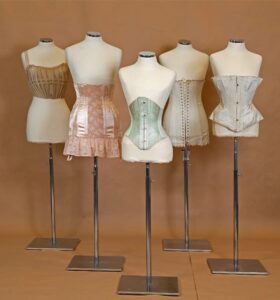by kwheele4 on February 25, 2021
Opinion

Trigger Warning: This piece discusses eating disorders.
By Elizabeth McGinn ’21
Opinion Guest Writer
A quick browse through any social media platform reveals today’s current trends, including baggy pants, middle-parted hair, and feathered eyebrows. However, one concerning trend is making a comeback from an infamous and symbolic garment in women’s fashion—the corset.
From Victoria’s Secret to TikTok and Instagram, young women have been sporting an item that their forebearers fought to free them from. The corset had been painted by early-wave feminism as the epitome of women’s oppression, as women were forced to wear clothing that restricted their mobility and breathing while upholding standards of femininity based upon thinness.
So, why are women wearing corsets again in 2021?
Some merely like the aesthetic; others find it sexually liberating. The bondage community has wholeheartedly embraced the corset, adding a nuance of sexuality to corsets today. This connotation, in conjunction with its history, makes the corset a symbolic hotbed.
Modern day corsets are typically much less physically restrictive than historical ones. In the late 1800s, doctors studied the health effects of corsets, finding common problems such as fainting, back problems, and restricted movement of the internal organs. When it fell out of style in the 1920s—thanks to the influence of women’s right’s movements—women could literally and figuratively take a breather.
While the majority of modern corsets do not carry the same physical dangers as historical ones, many are bought and worn in an effort to “waist train.” This corresponds more to the original purpose of corsets; waist training is an attempt to secure a slimmer figure through the restrictiveness of corsets. The increasing popularity of shapewear, similar in purpose to a waist trainer or corset, attests to the importance of women’s body shapes in fashion.
Although many women wear corsets merely for aesthetic purposes, the phenomenon of waist training is indicative of a much more pervasive issue in women’s fashion: the obsession with thinness.
While Lizzo and other celebrities attempt to promote body positivity, the norm among celebrities and within the fashion industry is extreme, waiflike thinness. Just last week, Kendall Jenner posted a mirror selfie that went viral for her tiny figure, with many commenters yearning for a body like hers or stating that they would not eat for the rest of the day.
The expectations of looking like Kendall Jenner or other models or influencers promote toxic behavior. With social media creating a mirage of a perfect life and perfect body, without acknowledging filters or photoshop, normal and healthy women may resort to unsafe measures to achieve the unattainable.
A slew of consequences occur from this impossible quest, including the rise of eating disorders in all genders and the emergence of a $60-billion-a-year diet industry. To put it shortly, businesses profit off women’s insecurities.
Because of society’s obsession with thinness, corsets are dangerous. Their original purpose was to mold the female body into a more slender shape, and while not all attempt to distort the body, waist trainers are becoming more and more popular. Even nearly a century after feminists fought for the rights of women to vote and wear pants, society still places immense pressure on women to look a certain way.
When the fashion industry actually commits itself to body positivity and celebrates all body types and shapes, perhaps then corsets can be reclaimed as something that is empowering instead of restrictive. Until then, corsets are a painful reminder of how oppressive women’s fashion has been—and will likely continue to be.